Lexical stress and phonetic processing in word learning in 20- to 24-month-old English-learning children
| dc.contributor.author | Floccia, Caroline | |
| dc.contributor.author | Nazzi, T | |
| dc.contributor.author | Austin, K | |
| dc.contributor.author | Arreckx, F | |
| dc.contributor.author | Goslin, Jeremy | |
| dc.date.accessioned | 2017-09-18T13:20:55Z | |
| dc.date.available | 2017-09-18T13:20:55Z | |
| dc.date.issued | 2010-11-02 | |
| dc.identifier.issn | 1363-755X | |
| dc.identifier.issn | 1467-7687 | |
| dc.identifier.uri | http://hdl.handle.net/10026.1/9955 | |
| dc.description | PubMed ID: 21477198 | |
| dc.description.abstract |
To investigate the interaction between segmental and supra-segmental stress-related information in early word learning, two experiments were conducted with 20- to 24-month-old English-learning children. In an adaptation of the object categorization study designed by Nazzi and Gopnik (2001), children were presented with pairs of novel objects whose labels differed by their initial consonant (Experiment 1) or their medial consonant (Experiment 2). Words were produced with a stress initial (trochaic) or a stress final (iambic) pattern. In both experiments successful word learning was established when the to-be-remembered contrast was embedded in a stressed syllable, but not when embedded in unstressed syllables. This was independent of the overall word pattern, trochaic or iambic, or the location of the phonemic contrast, word-initial or -medial. Results are discussed in light of the use of phonetic information in early lexical acquisition, highlighting the role of lexical stress and ambisyllabicity in early word processing. | |
| dc.format.extent | 602-613 | |
| dc.language | en | |
| dc.language.iso | en | |
| dc.publisher | Wiley | |
| dc.title | Lexical stress and phonetic processing in word learning in 20- to 24-month-old English-learning children | |
| dc.type | journal-article | |
| dc.type | Article | |
| plymouth.author-url | http://gateway.webofknowledge.com/gateway/Gateway.cgi?GWVersion=2&SrcApp=PARTNER_APP&SrcAuth=LinksAMR&KeyUT=000289302200014&DestLinkType=FullRecord&DestApp=ALL_WOS&UsrCustomerID=11bb513d99f797142bcfeffcc58ea008 | |
| plymouth.issue | 3 | |
| plymouth.volume | 14 | |
| plymouth.publication-status | Published | |
| plymouth.journal | DEVELOPMENTAL SCIENCE | |
| dc.identifier.doi | 10.1111/j.1467-7687.2010.01006.x | |
| plymouth.organisational-group | /Plymouth | |
| plymouth.organisational-group | /Plymouth/Faculty of Health | |
| plymouth.organisational-group | /Plymouth/REF 2021 Researchers by UoA | |
| plymouth.organisational-group | /Plymouth/REF 2021 Researchers by UoA/UoA04 Psychology, Psychiatry and Neuroscience | |
| plymouth.organisational-group | /Plymouth/REF 2021 Researchers by UoA/UoA04 Psychology, Psychiatry and Neuroscience/UoA04 REF peer reviewers | |
| plymouth.organisational-group | /Plymouth/Research Groups | |
| plymouth.organisational-group | /Plymouth/Research Groups/Centre for Brain, Cognition and Behaviour (CBCB) | |
| plymouth.organisational-group | /Plymouth/Research Groups/Centre for Brain, Cognition and Behaviour (CBCB)/Brain | |
| plymouth.organisational-group | /Plymouth/Research Groups/Centre for Brain, Cognition and Behaviour (CBCB)/Cognition | |
| plymouth.organisational-group | /Plymouth/Users by role | |
| plymouth.organisational-group | /Plymouth/Users by role/Academics | |
| dcterms.dateAccepted | 2010-07-19 | |
| dc.identifier.eissn | 1467-7687 | |
| dc.rights.embargoperiod | No embargo | |
| rioxxterms.versionofrecord | 10.1111/j.1467-7687.2010.01006.x | |
| rioxxterms.licenseref.uri | http://www.rioxx.net/licenses/all-rights-reserved | |
| rioxxterms.type | Journal Article/Review |


